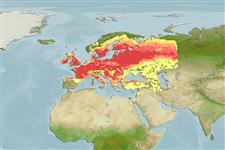Classification / Names
Common names from other countries
Main reference
Size / Weight / Age
Max length : 82.0 cm TL male/unsexed; (Ref. 6114); common length : 25.0 cm TL male/unsexed; (Ref. 3561); max. published weight: 6.0 kg (Ref. 4699); max. reported age: 23 years (Ref. 796)
Length at first maturity
Lm ? range ? - ? cm
Environment
Freshwater; brackish; benthopelagic; pH range: 7.0 - 7.5; dH range: 15 - ?; potamodromous (Ref. 51243); depth range 1 - ? m (Ref. 9696)
Climate / Range
Temperate; 10°C - 24°C (Ref. 2059), preferred ?; 75°N - 40°N, 11°W - 73°E
Distribution
Europe and Asia: most European drainages from Adour (France) to Pechora (White Sea basin); Aegean Sea basin, in Lake Volvi and Struma and Maritza drainages. Naturally absent from Iberian Peninsula, Adriatic basin, Italy, Scotland, Scandinavia north of Bergen (Norway) and 67°N (Finland). Locally introduced in Ireland, Spain and northeastern Italy. In Asia, from Marmara basin (Turkey) and eastward to Aral basin. Introduced in Lake Baikal and upper Ob and Yenisei drainages.
Countries | FAO areas | Ecosystems | Occurrences | Introductions
Short description
Dorsal
spines
(total): 3;
Dorsal
soft rays
(total): 9-10;
Anal
spines: 3;
Anal
soft rays: 23 - 30;
Vertebrae: 43 - 45. The only species of the genus which can be diagnosed from other species of Ballerus, Blicca and Vimba by the following characters: mouth sub-inferior, which can be extended as a tube; lateral line with 51-60 scales; anal fin with 30½ branched rays; eye diameter about 2/3 of snout length in individuals larger than 10 cm SL; pharyngeal teeth 5-5; and base of paired fins hyaline or grey (Ref. 59043). Caudal fin with 19 rays (Ref. 2196). Tall, laterally compressed body. Fins darker in adults. Anal fin base twice as long as the dorsal fin (Ref. 35388).
IUCN Red List Status (Ref. 115185)
Threat to humans
Harmless
Human uses
Fisheries: highly commercial; aquaculture: commercial; gamefish: yes; bait: usually
Tools
Special reports
Download XML
Internet sources
Estimates of some properties based on models
Phylogenetic diversity index
PD50 = 1.0000 many relatives (e.g. carps) 0.5 - 2.0 few relatives (e.g. lungfishes)
Trophic Level
3.1 ±0.1 se; Based on diet studies.
Resilience
Low, minimum population doubling time 4.5 - 14 years (K=0.06-0.17; tm=3-5; tmax=17; Fec=90,000-340,000)
Vulnerability
High vulnerability (56 of 100)
Price category
